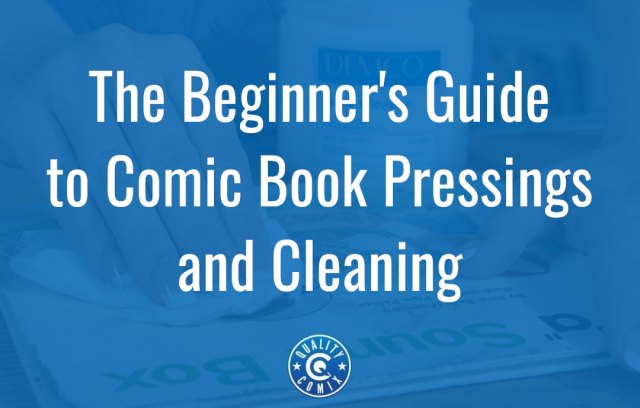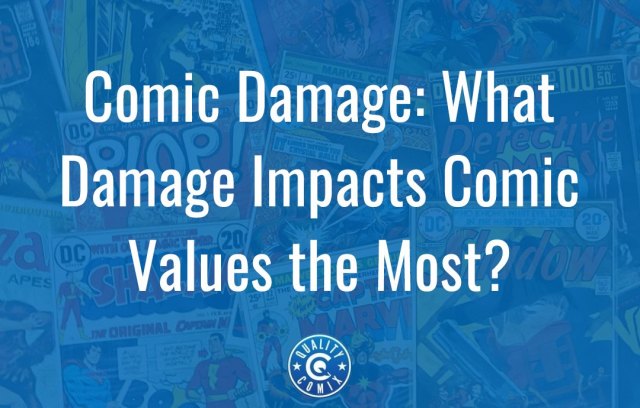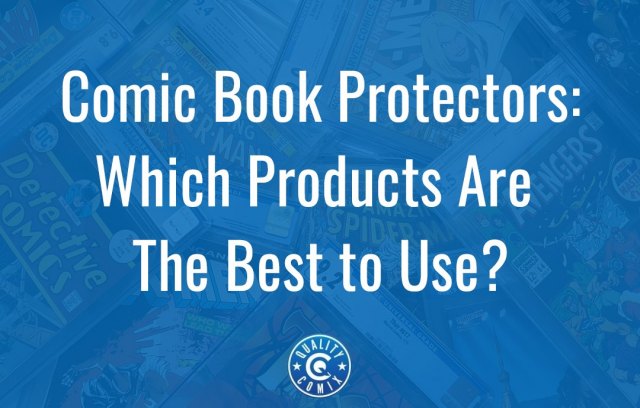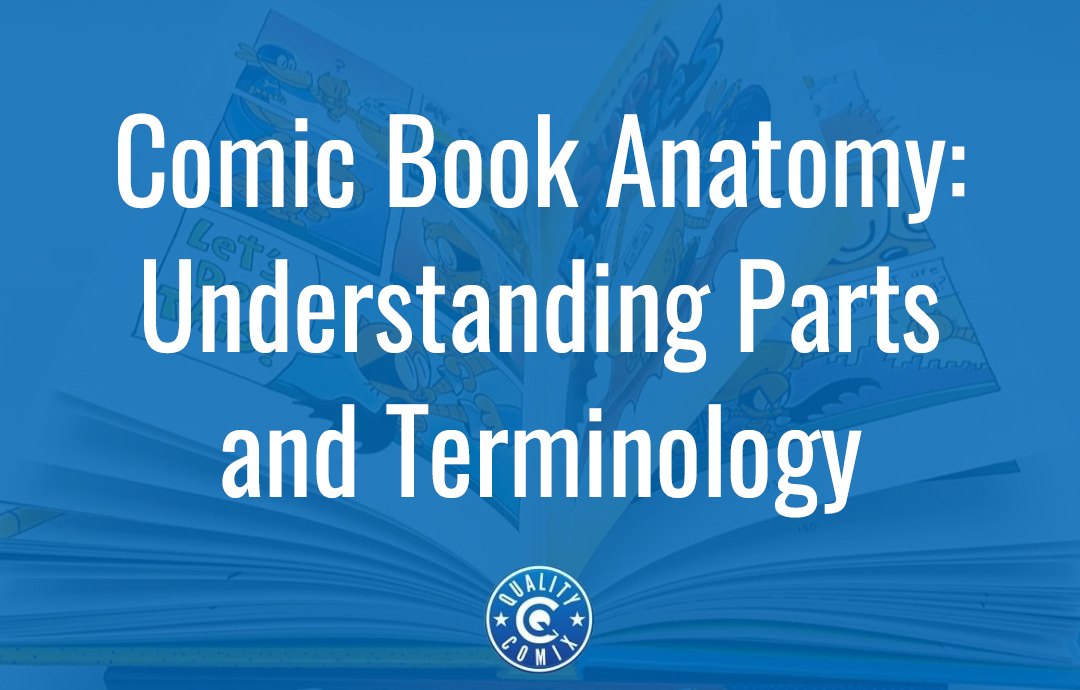
Throughout all of our posts on the subject, we use a lot of terms that are unique to the industry. Many of them refer to things like the ages of a comic book, the era it's from, and other more industry-wide terms. For these, we produced a glossary of comics industry terms, which you can find here.
Other terms refer to the books themselves and specific aspects of them. Those are a little narrower and more precisely defined, so it's time to go over them today. Stick around and join us for a deep review of comic book anatomy. What makes a comic book? As it happens, comics are relatively simple.
Cover
The cover of a comic book is a full page-sized piece of paper, but it's often – though not always – made of a more durable, glossier, or otherwise treated paper that gives the comic itself a bit of protection. Covers are folded in the middle, where the binding is, and divided into front and back. The front cover has all the elements of the comic on it: the title, the issue number, information about the publisher and author, the UPC, and so on. It may also have unique treatments, like embossing, foiling, or other decoration.
The back cover, meanwhile, may have little or nothing on it, or it may be an extended piece of artwork, a promo for another comic, or something altogether different. Some of them, like paperback books, have descriptions of the contents of the comic. It varies by book, line, publisher, and even era.
Covers are extremely important to comics for a lot of reasons. Obviously, they're the critical display piece of a comic; people look at the cover to know what the comic is. Even if the actual reason the comic is valuable is something inside it, like the first appearance of a character, the cover is still incredibly important.
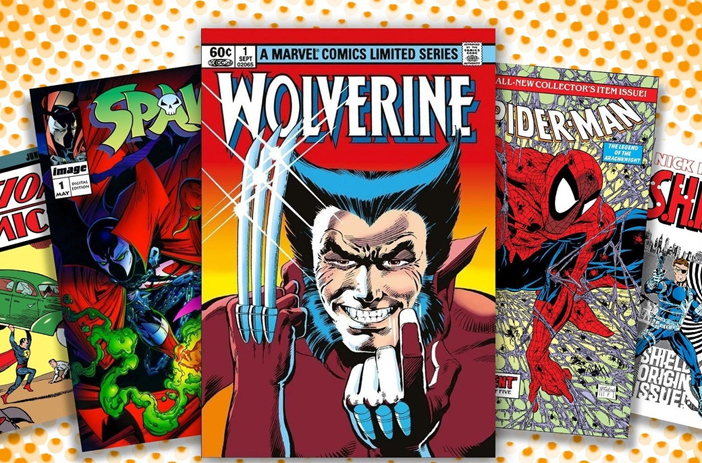
Covers are also slightly rarer than the comics themselves. This is because, as a comic book is read, stored, moved, and otherwise interacted with over time, stress is put on the paper around the binding staples. That stress is greatest on the outermost page, which is the cover. A comic that has been read numerous times is more likely to have that paper wear or tear away, and the cover can fall off entirely. Sometimes, covers are lost.
There's also the rare case of potential fraud relating to the cover. The most famous instance of this is the line of reprints called Famous First Editions. These were completely identical reprints of very valuable comics, like Action Comics #1, except they had an additional outer cover added to them that made it clear that they were reprints. Well, if you removed that outer cover, the first page looked just like the cover of the original. People thought they could pass off these reprints as the originals by doing so.
Now, the comics were different physical dimensions, with the reprints being larger, so this is actually relatively easy to identify if you know what you're looking at. But it just goes to show how important a cover is.
Another way covers are important is the inside of them. The inner side of the cover, both front and back, is also content. Often, this is where the "indicia" of a comic is, which is the fine print talking about the print run, edition, information about the writers and illustrators, the copyright notices, and disclaimers. Being able to see and identify this information is also very important to certain comics because differences in edition can be huge for reprints and reissues.
Spine
The spine of the comic is the left-hand edge as you hold it, where the pages come together. All of the pages in a comic book are twice as wide as the book itself and are folded over, with staples in the center to hold them all together. The proper alignment of these pages is what makes a comic into a book.
Over the many years of the history of print media, all manner of different kinds of binding have been used. In the old days, books would be bound with thread, holes carefully punched in sheaves of paper, and the whole thing sewn together before a cover was glued on. This is why a common failure point for very old books is the cover coming loose, but all the pages stick together because they're sewn with a more durable thread.
More modern versions – and something that is used for things like trade paperbacks and omnibus volumes – use a simple glue. All of the pages are stacked together, the edges are trimmed, and they're all glued into the cover. This is fairly durable and resilient these days, and it eliminates the single point of failure that staples represent. However, it leads to much more stress on the spine all up and down the cover, so you often see marks of creasing for bound volumes that have been read frequently.
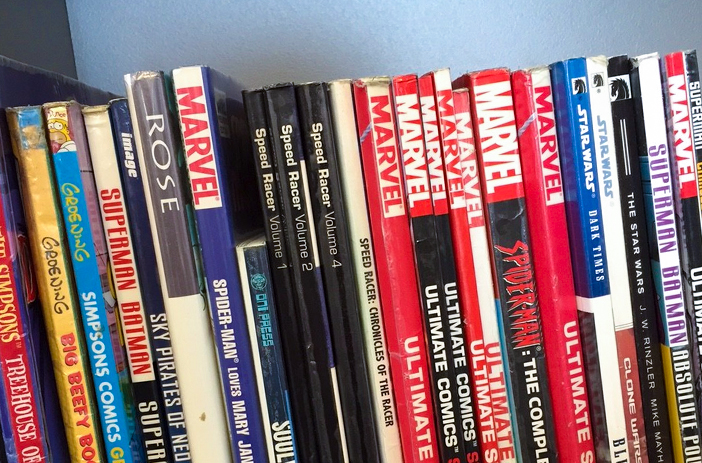
Note: One pretty cool thing you can find very rarely is "volumes" made up of actual printed versions of the comics. These come in two forms: the ones made by people who just loved their comics and wanted to make their own bound copies and the same thing made by the actual publishers. When publishers made them, they would be labeled and marked in some way, and they were generally used as prototypes to decide on things like layout changes, page order changes, or places to insert advertising. These are extremely rare and, often, quite valuable. The ones made by collectors, meanwhile, can be interesting novelties but aren't worth a premium because they're technically just damaged comic books.
The vast majority of comic books produced, which aren't trade paperbacks or other collections, are simply held together with staples. It may not be the most durable option, but it's the cheapest and easiest to mass produce, and for something meant to be disposable like comics, that's all they ever needed.
Staples
The staples are, well, staples. There's not actually anything really noteworthy about them. They're little bits of metal that are pressed through the paper and folded over to hold the pages in place. Sometimes, they're immaculately placed, and sometimes, binding errors shove them in seemingly random places.
Despite how standard and ordinary they are, staples are an incredibly important part of the value of a comic book. Staples can rust over time, which means they can stain the paper around them. Staples are a point of stress, so when a comic is read and handled, that's where damage can accumulate. Staples are also easy to break over time.
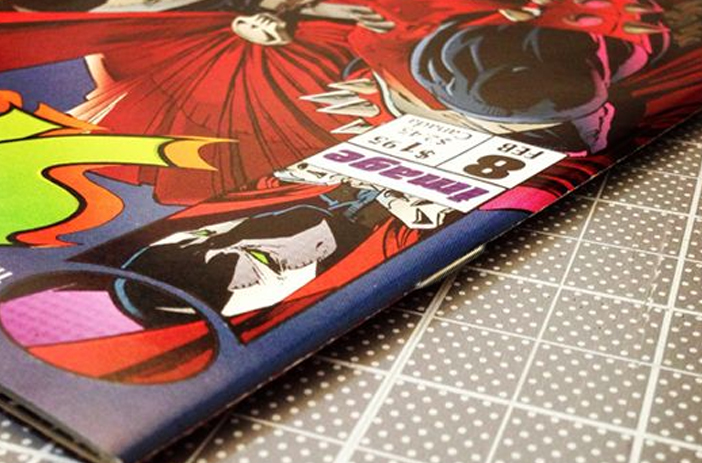
Since a comic book's value is tied to its condition, there's a semi-common bit of fraud that some people will do. They buy multiple damaged copies of comics, and they carefully remove the staples from all of them. They pick the best pages from each, piece them together, and carefully put staples back in place to make it look more pristine.
There are ways to identify and detect this. You can check to see if the staple holes have been widened slightly or if the staple is out of alignment. You can check if the pages aren't all the same quality or the same level of wear. You can even examine the staples very closely to see if they look like they've been cleaned at some point in the past. Here are a few examples of how to identify this kind of tampering.
Now, is this kind of tampering going to be hugely relevant to most people? Probably not. It only really happens on older, rarer, more valuable comics that the owner stands to gain a lot from if the comic is in better condition. Fortunately, it's also one of the things that grading companies look for, and they can slap a "restored" label on a comic, which is practically a death sentence for the value for many collectors.
Pages
Pages are, you guessed it, pages! The pages of a comic are sometimes, but not always, made of slightly worse paper – or, at the very least, a different kind of paper – from the covers. There are usually about 32 pages in a typical comic. In older comics, they're made of a rough paper that turns brown over time and has a dull finish. More modern comics use a glossier paper and have less in the way of gutters and other space that can show fading or loss of color over time.
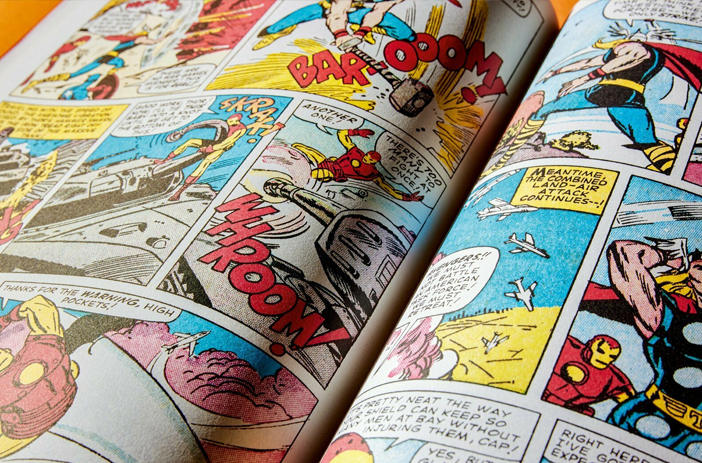
Image source: Comic Quest
Pages make up the bulk of the comic. They have all of the content of the story, they have advertising, they have promos for the next issue, they have credits, letters to the editor, notes from the authors, and anything else deemed worth printing into a comic. They're the meat and potatoes of a comic book, and while they're very important in terms of condition and quality, it's the cover that really makes or breaks the value of a high-end comic book.
Coupons
Back in the old days, comics were a newsstand product, and like many such products, they were used not just as a way to tell a story but as a way to advertise and sell products. Thus, many comics would have pages that would be advertising for a product, be it a book, another comic, or something completely unrelated.
In many cases, these comics would also include a coupon on that advertising page. It was meant to be something you would physically cut out of the book, fill out, and send in, and a product or sample or whatever would be mailed to you. Sometimes, you could redeem them for prizes, and sometimes they were collectible like stamps.
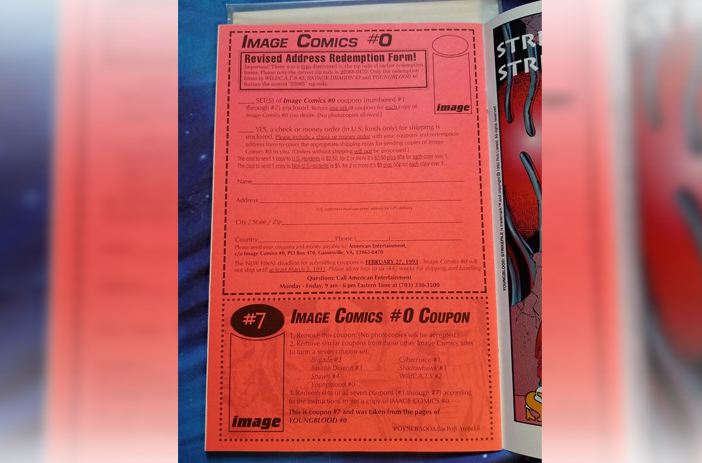
Image source: eBay
In any case, the core detail is that they were meant to be cut out of the comic. These days, especially amongst collectors, the idea of cutting a chunk out of a comic's page is unheard of, practically blasphemy. Back then, though, since comics were considered disposable, it was common for these coupons to be redeemed.
A comic is considered "intact" if all of the various pack-ins and coupons are present. However, since their removal was so common, and they're not an essential part of a comic story, certain comics are not actually considered damaged if these elements are missing; it's more of a rare bonus to have it than a loss to not have it.
Pack-Ins
In addition to coupons, comics often had other kinds of pack-ins. They might have postcards that you pull out and mail in to subscribe to a comic. They might have full-page art pieces meant to be removed and hung up like posters. They might even have whole posters, centerfold-style larger pieces of paper folded in, meant to be removed and displayed. In the 90s, as well, there were all sorts of gimmicks, including things like cardboard red/blue 3D glasses that you could remove to read part or all of the comic in stunning 3D.
Comics have had some crazy times over the years when you think about it.
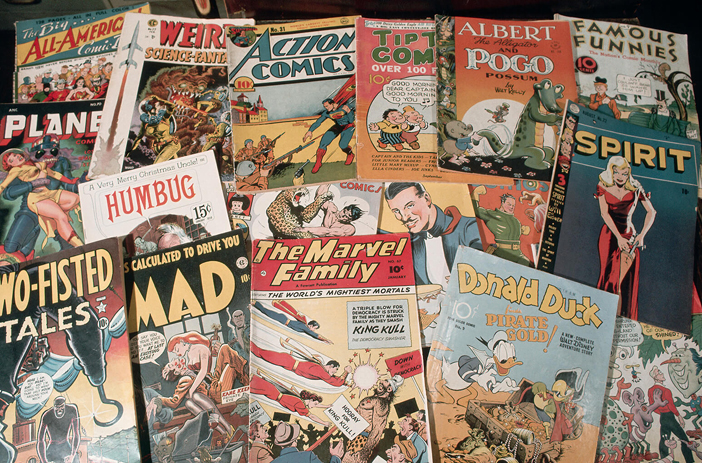
Many pack-ins are, like coupons, not considered damage if they aren't there, simply because it's so rare for any of them to have survived. Those that have survived add value to the comic when graded and sold.
Any Questions?
Comics, as you can see, aren't terribly complex pieces of media. At the core, they're really just a bunch of pieces of paper with art and writing on them, folded and stapled together. Everything else is, as they say, a bonus.
But what a difference that bonus makes, eh? Comics these days can be worth incredible amounts of money, and so much of that value comes down to very small details.
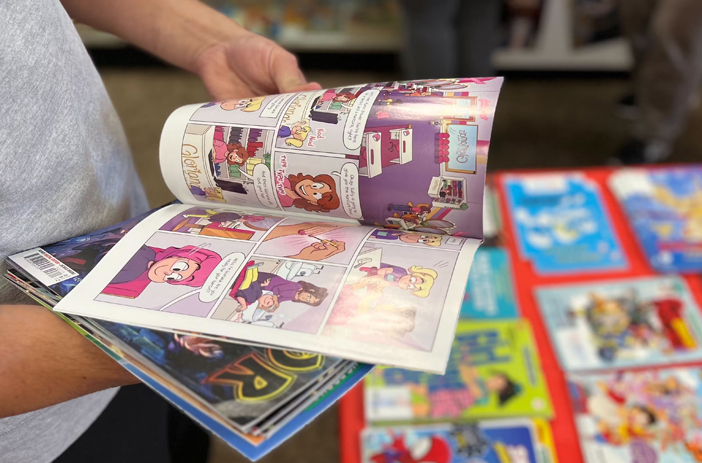
So, do you have any questions? Are there terms you've heard that we haven't covered, either here or in our general terminology guide? Do you have questions about pack-ins or other items that we didn't mention? Feel free to drop us a line or just leave us a comment.
In the meantime, if you're interested in buying some high-end comics or have some of your own to sell, you've come to the right place. As one of the leading dealers in high-end comics, we're more than happy to talk about any deal you'd like to make, from selling an inherited collection to buying a new piece to build your own.
We look forward to hearing from you!

